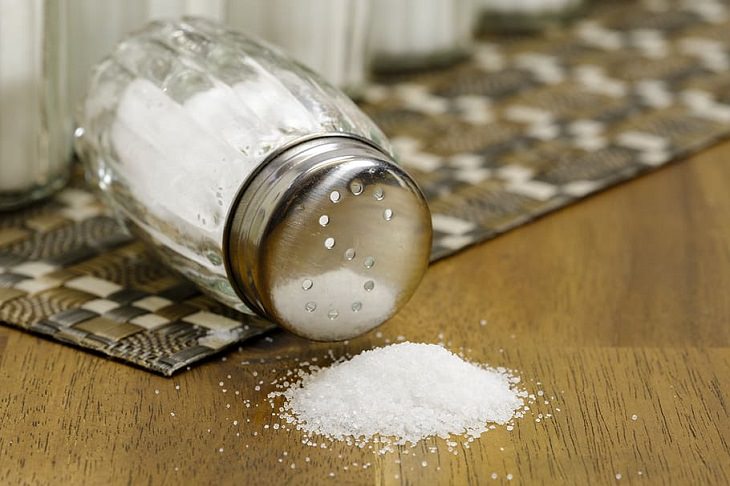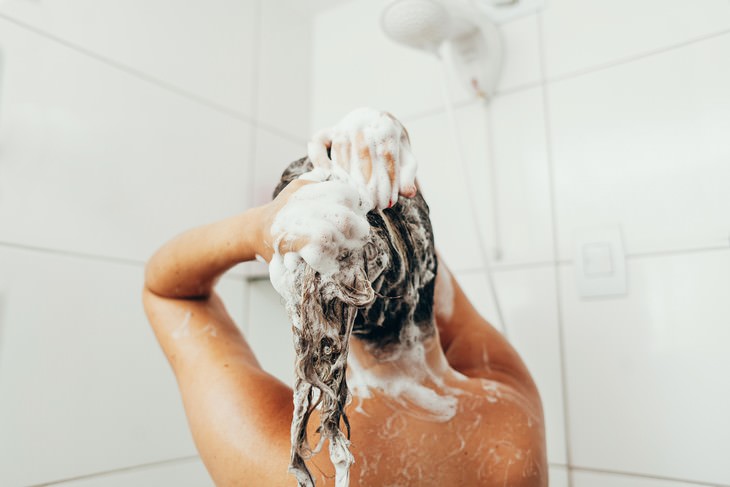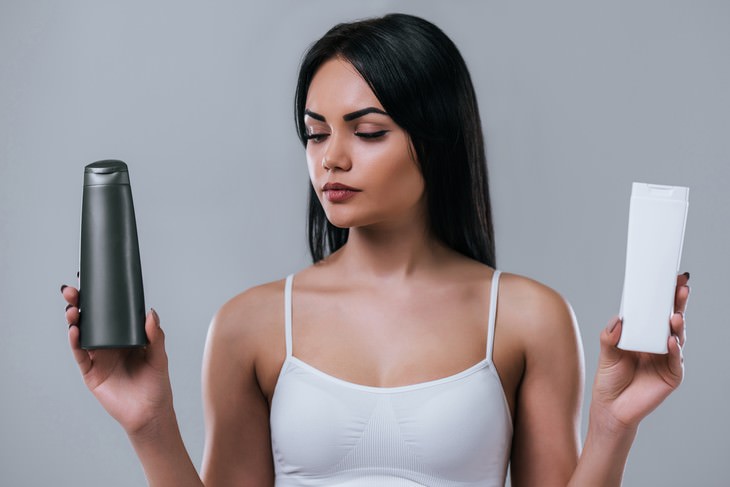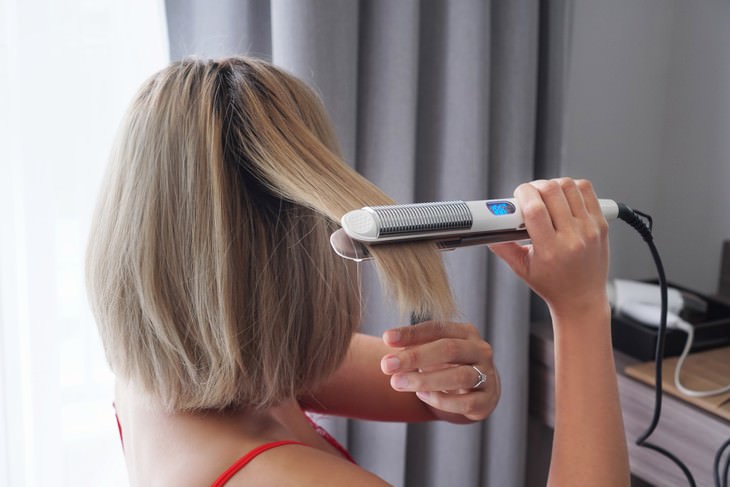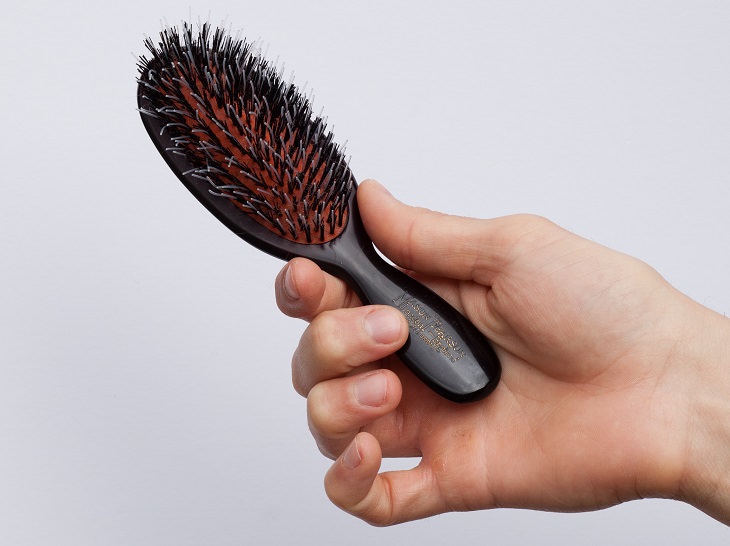1. Add salt to your shampoo
If your scalp produces too much oil, you can balance it out by simply adding salt into your shampoo. To use this trick, add 2 tablespoons of salt into a 16 oz (450 ml) bottle of shampoo, shake the bottle, wait for the salt to dissolve, and then use it as usual. You will see the effects of the salt after a few washes: your hair will not get oily as fast and you will also have more volume in your hair.
We prefer using Epsom salt, as it's higher in minerals, such as magnesium, and can nourish and promote the health of your scalp while making it less oily, but any salt will do the job just as well.
2. Use dry shampoo
Dry shampoos are powders that come either in aerosol cans or regular bottles that you spray directly onto the roots of the hair to reduce the appearance of oily hair without having to wash the hair. These products will help you extend the time between washes for a day or two, and they are widely available both online and in drugstores or beauty stores.
To use the dry shampoo, simply apply the product directly onto the areas of your hair that are the oiliest. If you have long hair, you might have to divide the hair into sections before applying the product. Let the dry shampoo sit in the hair for a few minutes to allow it to soak up the oils, and then brush through your hair to avoid any white residue being left behind.
3. Dry shampoo alternatives
If you don't feel like investing in dry shampoo, or you simply need a quick fix in a pinch but have no dry shampoo on hand, you can also use a small amount of baby powder, cornstarch, or cacao powder (for dark hair) as a replacement for dry shampoo. These products are typically not as effective as dry shampoo because they're not designed to be used on hair, but they do work.
Products that contain a lot of alcohol, such as hand sanitizer, alcohol wipes, or even perfume can also be used to soak up the excess oils from your scalp. To use these, rub a small amount of the product onto the oily areas of the scalp, and after a few minutes - the product will evaporate and absorb the oils.
4. Wash your hair less often
The natural oils your scalp produces are there for a reason. Much like the sebaceous glands on the rest of the skin, the oil glands in your scalp produce sebum to moisturize and protect your scalp from damage. Shampoos strip the hair and scalp of these natural oils. The more you wash your hair, the more oils your scalp is forced to produce.
Many people find that by washing their hair less often, they actually experience less oil production in their hair. So, if you wash your hair every day, try doing so every other day, and this change alone may help train your scalp to become less oily with time.
5. Not all hair care products are the same
Similarly to the way there are different skincare products that are targeted towards different skin types (oily, dry, combo, sensitive), hair care is manufactured to suit different hair types as well. If you have oily hair, using a shampoo or conditioner that is targeted at dry or bleached hair and contains more moisturizing ingredients may actually do you a disservice, especially if you use it all the time. Instead, occasionally use clarifying and volumizing shampoos that will help control the oil production and clarify your scalp.
It's also best to avoid styling creams or mousses if you have oily hair, as these often contain waxes and oils that can make your hair look even oilier and weigh it down. If your hair is oily at the roots, but dry at the ends, however, you can use hair oils and styling creams, but avoid applying them to the roots of the hair.
6. Don't apply conditioner on the roots
If you already have greasy hair, it means that the oil glands in your scalp are already doing an excellent job at moisturizing the roots of your hair, and using conditioner in the root area would only make your hair greasier. Instead, apply conditioner only at the ends. Also, if you have really short and oily hair, you can easily skip conditioner altogether.
7. Don't straighten your hair
If your hair is really oily, straightening it will only enhance the oiliness, as straight hair is much closer to the scalp than curly or wavy hair. For this reason, leaving a wave or curl into your hair can actually make your hair more voluminous, and hence - less oily. Occasionally, you can straighten your hair, but make sure to add dry shampoo right after styling your hair, as this will help keep your hair oil-free for longer.
8. Brush strategically
Like straightening, frequent brushing sleeks down your hair, which forces closer contact of the hair with the sebum of the scalp, so only brush your hair when you're styling it in the morning and then once more before bed.
Apart from that, the brush you use matters, too, as natural bristled brushes, such as wooden combs and boar bristle brushes actually absorb some of the oils from your scalp and help distribute them more evenly throughout the hair all the way to your ends as you're brushing your hair. This will not only help your oily scalp but will also make your entire hair shinier.
9. Use scalp scrubs
Exfoliating your scalp is another excellent method to train your hair to produce less oil. There are many scalp scrubs that contain charcoal or salt that help absorb sebum available in stores today, but you can also make your own DIY scrub at home from ingredients you may already have at home.
To prepare your own scalp scrub, combine 1 tablespoon of melted coconut oil, 2 tablespoons of sugar, 1 teaspoon of honey and 3 drops of rosemary essential oil in a small bowl. Wet your hair before applying the mask onto your scalp and massage the scalp for a few minutes, then leave the mask on for 10-15 minutes, subsequently washing your hair with shampoo and applying a conditioner as usual.
Apart from making your hair less oily, this mask is excellent for hair growth, preventing dandruff, and increasing blood circulation in the scalp. It is recommended to use this mask once a week to see significant results.

